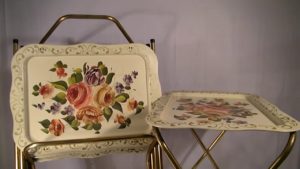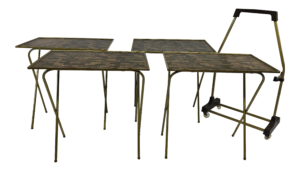
Rumors of only one nostalgic journey this week are greatly exaggerated. My internet connection is doing much better, thank you.
The living room of the 1960’s was a warm, friendly place. True, times had changed since our parents might have first purchased our modest homes fifteen of twenty years prior. Most living rooms in the US had a new center of attention: the television set. That one-eyed monster changed the purpose of the home’s central location from a place of casual conversation, or possibly listening to the radio, to the spot where our parents unwound after a long day at work, accompanied by a cocktail, Walter Cronkite, a cigarette, and a TV dinner.
That piping hot little aluminum dish required special accommodation. It was certainly too hot to sit on one’s lap.
Enter the aluminum folding TV tray.
Evidence exists that the TV tray actually preceded the TV dinner by a year. I traced the much-maligned meal back to possibly 1953. But In her book As Seen on TV: The Visual Culture of Everyday Life in the 1950s, author Karal Ann Marling states that national advertising for TV tray tables first appeared in 1952.
By 1967, there was scarcely a home in the suburbs that didn’t have a stash of neatly folded TV trays placed inobtrusively away in a corner somewhere, ready for instant deployment at around 5:30 in the evening.
The earliest examples of TV trays have legs that are constructed lengthwise in the shape of an X that prevented you from placing your human legs comfortably under the tiny table surface. Manufacturers soon reworked the design so that the tubular legs folded along the shorter axes, with the tray top itself dropping down to create a tiny little piece of furniture that fit perfectly out of sight into a space of just a few inches.
Sheer engineering genius!

Thus did millions of the diminutive home accessories change hands at various stores and find themselves in our childhood homes.
The flimsy trays were just sturdy enough to support a TV dinner and a drink. and possibly an ash tray. Add anything else to the load, and you did so at your own risk.
Thus did I learn a valuable life lesson at the age of thirteen: Don’t attempt to assemble a model sailing ship on a TV tray that might possibly collapse, taking paint, glue, rigging string, and various plastic parts with it to the floor.
TV trays sold moderately well in the early 50’s, but as TV dinners themselves began to be marketed, and more and more US homes began sporting shiny new television sets, their sales went through the roof.
And the best thing about them is their sheer indestructible nature.
Thus, fifty-year-old trays may well be in service, having been passed down from parents and grandparents, and now holding a nouveau chic status in this world gone retro-crazy.
The legs might become bent, plastic clips may break, but the metal itself is impervious to rust. Thus, even badly scratched up examples that saw action when Bonanza was on Sunday nights are likely still serving, possibly holding small pots populated by African violets on a screened-in porch somewhere.
And someday, hundreds or thousands of years hence, perfectly functional examples will likely be recovered from landfills by future archaeologists.
Overall, a pretty cool legacy for a cheap, yet brilliant invention.
I’m looking for “heavy plastic fittings” that the metal tubular legs fit into and were pop riveted into the bottom of the tray. I believe the legs are 1/2 inch in diameter.
I need 2 of each for now to complete 1 tv tray.